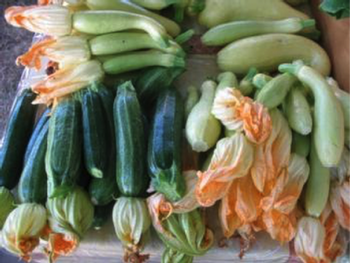Squash - Summer
-
Scientific NameCucurbita pepa
-
General InformationEasy, prolific warm season vegetable. Good source of vitamin A and potassium. High producer; bears fruit until weather cools in the fall. Many varieties, shapes, and colors: yellow, straight or crooked necked, saucer, scallop or patty pan, and oblong, green, gray or yellow zucchini. Bush and vining varieties are available.
 Photo: Courtesy UC Regents
Photo: Courtesy UC Regents -
When to Plant
Seed indoors in March and plant seeds and/or starts mid-April through June. Depending on variety, some starts may be planted into July. For best results, wait until the soil is well-warmed in spring and night temperatures are above 55 degrees.
-
Planting
Prepare bed several weeks before planting. When ready to plant, make a circular trench and build within it a 12 inch, flat topped mound. Irrigate. Plant seeds in these mounds. Summer squash needs to be planted where it will receive a minimum of six hours of full sun.
Seeds: Plant five to six seeds one to one and a half inches deep in a circle around a mound. Thin to the two largest plants when they are three inches tall. Check the back of the seed packet for details. To get an early start, plant seeds indoors three to four weeks before the danger of frost has passed and transplant into the garden.
Starts: For transplants, plant two seedlings per circular trench, about 6 inches apart. Pick young plants with four to six true leaves and slightly hardened to outdoor conditions. Bury the stem up to the first leaf and press the soil firmly around the plant. If transplanting in summer, shade plants in the middle of the day for the first week or use a floating row cover.
-
Soil Requirements
Squash do well in a wide range of soils, but perform best in well-drained soils. They prefer soil rich in organic matter, so add plenty of compost and/or composted manure before planting. Aim for soil pH between 5.8 to 7.
-
Water Requirements
Keep soil moist during seeding and germination. Regular, even watering is key. The majority of the roots are in the top 12 to 18 inches of soil, so it is important to irrigate properly to avoid water stress (drying out) or excessive wetness. Like tomatoes, squash is susceptible to blossom end rot caused by uneven watering and calcium deficiency. Too little moisture can result in misshapen fruit, while too much water will encourage root and stem diseases.
-
Fertilizing
If the soil has been properly amended with compost or manures or other organic materials, the only nutrient needed is nitrogen. If this organic material has not been used, apply nitrogen and phosphorus via a good organic vegetable fertilizer. Follow directions on package as too much nitrogen can produce lots of leaves and few fruit. Squash are heavy feeders. Consider light but frequent applications of organic nitrogen fertilizer every three to four weeks. Avoid letting the fertilizer come into contact with the plant stems to avoid burning.
-
Pollination
Not self-pollinating. Squash plants have male and female flowers on the same plant. Male pollen must be transferred to female flower for pollination to occur. Honeybees are the principal pollinators. Hand pollination is an option in areas with few honeybees.
-
Harvesting
Harvest when skin is tender and the seeds are immature. Harvest zucchini when six to eight inches long and one and a half to two inches in diameter; patty-pan types, when three to four inches in diameter; yellow crookneck, when four to seven inches in diameter. Leaving the fruit on too long results in massive, tough fruits, and fewer fruits.
-
Storage
Fresh summer squash can be stored in the refrigerator for up to ten days. Summer squash can also be frozen. Wash, trim and slice or dice squash. Blanch in boiling water for three minutes for one a a quarter inch slices or one-half inch diced pieces; six minutes for one a half inch slices. (Allow one gallon of water per pound of vegetables). Cool immediately in ice water. Drain and pack into moisture/ vapor-resistant freezer containers. Seal and store at 0°F.
-
Good Varieties for Marin
Compact or bush varieties:
‘Peter Pan Hybrid’ (bush with miniature light green pattypan fruit)
‘Scallopini’ (bush with dark green speckled pattypan fruit)
‘Early White Bush’ (white pattypan)
‘Sundance’ (high-yield yellow crookneck)Requires less water when established:
‘Cocozelle’ (an Italian heirloom bush variety)
‘Costata Romanesco’ (a traditional Italian heirloom with heavy male blossom buds for cooking)
‘Dark Star’ (a big, tall variety with spineless stalks)
‘Lebanese Light Green’ (a mild and tender bush variety) -
Helpful Tips
Plant disease-resistant varieties. Keep soil evenly watered to avoid deformed fruit. May have to rely on hand pollination if there are not enough honeybees to pollinate.
-
Common Problems
Powdery mildew – causes include plants spaced too close together and overhead watering.
Misshapen fruit and poor yield - too few honeybees present and only partial pollination occurs. Hand pollinate female flowers with pollen from male flowers to increase yield.
Blossom end rot - causes include uneven watering and/or calcium deficiency. Check your irrigation and calcium levels in soil. Adding agricultural lime to the soil in autumn will raise calcium in the soil. Eggshells in your compost will also add calcium to soil.
-
Pests- Diseases & More
Cucumber beetle, squash bugs, powdery mildew

